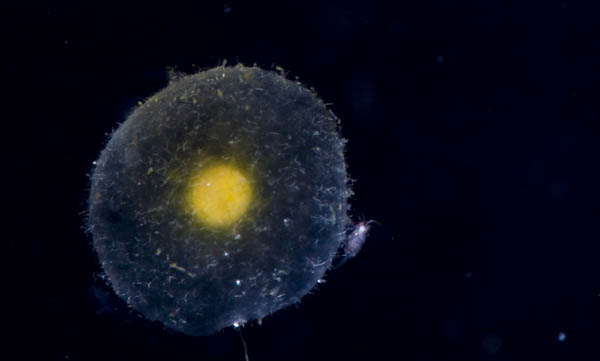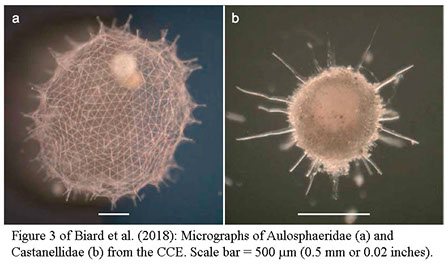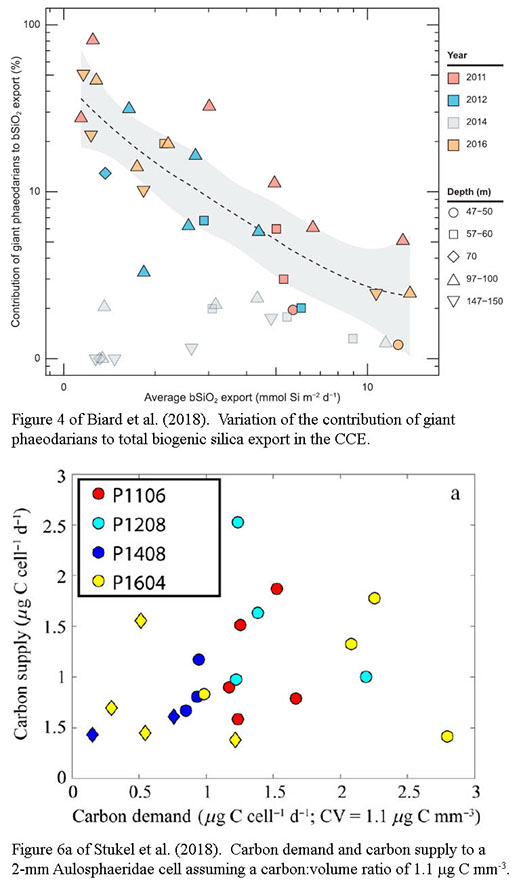Phaeodaria: Giant Single-Celled Protists
Protists (or single-celled eukaryotic organisms) are typically tiny. They typically fall into what we call the nanoplankton (2 - 20 micron) or microplankton (20 - 200 micron). To put that in perspective, you could line up 500 of the smallest nanoplankton and the length of your line would only be the width of a dime. However, there is one group of protists, called Rhizaria, that often get much larger. This group, which includes Foraminifera, Radiolaria, Phaeodaria, and Acantharia, has hard skeletons (made of materials similar to glass or chalk) and can reach diameters greater than one millimeter. This puts them at a similar size to (or even larger than) more common metazoan mesozooplankton, such as copepods. Rhizaria, were originally believed to be relatively unimportant in the pelagic ocean, because they were seldom found in bottle samples (which are used for the much smaller protists) and were not often noticed in net tows (used for mesozooplankton), because they get destroyed by the nets. However, recently one of my colleagues (Tristan Biard) used millions of images taken around the world by a special camera system (called the Underwater Video Profiler or UVP) to show that Rhizaria are actually incredibly abundant (Biard et al., 2016). Unraveling the ecological and biogeochemical role of these organisms thus took on a much greater significance.
 On a cruise in the Costa Rica Dome in 2010, I was taking a cursory look at my sediment trap samples to look at the sinking particles and I noticed a lot of phaeodarians in the sample. However, when I undertook more detailed analyses on land several months later I could no longer find the phaeodarians. They had either been destroyed in transport or dissolved during storage. A year later I was at sea on a CCE cruise with a friend of mine (Jeff Krause) who studies the silica cycle. When I mentioned the phaeodarians to him, he got interested in their potential role in the silica cycle, so we agreed that I would start counting the phaeodaria in the sediment traps while at sea (before they could dissolve) and that I would pick some out to give Jeff to measure their silica content. At the same time, Mark Ohman (the lead investigator for CCE) had been brought in colleagues to deploy the UVP on CCE cruises. Several years later, when Tristan published his manuscript showing that Phaeodaria and other Rhizaria were globally abundant, Mark invited him to join CCE as a post-doc, and the four of us got together to combine our data to try to actually figure out what these fascinating organisms were doing.
On a cruise in the Costa Rica Dome in 2010, I was taking a cursory look at my sediment trap samples to look at the sinking particles and I noticed a lot of phaeodarians in the sample. However, when I undertook more detailed analyses on land several months later I could no longer find the phaeodarians. They had either been destroyed in transport or dissolved during storage. A year later I was at sea on a CCE cruise with a friend of mine (Jeff Krause) who studies the silica cycle. When I mentioned the phaeodarians to him, he got interested in their potential role in the silica cycle, so we agreed that I would start counting the phaeodaria in the sediment traps while at sea (before they could dissolve) and that I would pick some out to give Jeff to measure their silica content. At the same time, Mark Ohman (the lead investigator for CCE) had been brought in colleagues to deploy the UVP on CCE cruises. Several years later, when Tristan published his manuscript showing that Phaeodaria and other Rhizaria were globally abundant, Mark invited him to join CCE as a post-doc, and the four of us got together to combine our data to try to actually figure out what these fascinating organisms were doing.
 We found that large Phaeodaria, and especially two taxa called Aulosphaeridae and Castanellidae, were incredibly abundant in the CCE and important contributors to sinking flux. However, unlike most mesozooplankton, they lived beneath the sunlit layer of the ocean. They were normally found at a depth of 100 m (~330 feet), where they probably make a living by catching and feeding on sinking particles. Because of their large, dense silica shells, they comprised an average of 10% of the sinking silica. However, in the oligotrophic (low nutrient and low biomass) waters far from shore, they were actually responsible for most of the sinking silica (Biard et al., 2018). This challenges oceanographers' conventional view that sinking silica in the ocean is driven almost entirely by diatoms (an abundant type of algae).
We found that large Phaeodaria, and especially two taxa called Aulosphaeridae and Castanellidae, were incredibly abundant in the CCE and important contributors to sinking flux. However, unlike most mesozooplankton, they lived beneath the sunlit layer of the ocean. They were normally found at a depth of 100 m (~330 feet), where they probably make a living by catching and feeding on sinking particles. Because of their large, dense silica shells, they comprised an average of 10% of the sinking silica. However, in the oligotrophic (low nutrient and low biomass) waters far from shore, they were actually responsible for most of the sinking silica (Biard et al., 2018). This challenges oceanographers' conventional view that sinking silica in the ocean is driven almost entirely by diatoms (an abundant type of algae).
We also looked at the role that Aulosphaeridae play in consuming sinking particles. Because we knew the abundance and size of these organisms, we could calculate the percentage of sinking particles that they would intercept. By combining this calculation with our measurements of sinking carbon, we were able to determine how much food the Aulosphaeridae were getting and also what percentage of total sinking particle consumption they were responsible (Stukel et al. 2018). Our results showed that Aulosphaeridae alone (just one phaeodarian taxon) could be responsible for as much as 20% of carbon flux attenuation in the shallow twilight zone). Importantly, our estimates of the sinking losses of (dead) Aulosphaeridae allowed us to estimate a lower limit for their mortality rates. If the population is neither increasing nor decreasing substantially over time, we would expect this mortality rate to be similar to the growth rate. Using these assumptions, we estimated that Aulosphaeridae growth rates were approximately 0.1 - 0.2 per day and that their life spans were roughly one week. When we compared their growth rates to the amount of carbon they were potentially consuming, we found that they could only attain sufficient carbon for growth if the Aulosphaeridae had very low carbon to volume ratios. This suggests that Aulosphaeridae is especially adapted to have a large silica skeleton that effectively increases their surface area (allowing them to capture many sinking particles) but is filled mostly with water so that the organisms do not need to much food to grow (Stukel et al. 2018). We also found that there was high interannual variability in the abundance of Aulosphaeridae and that this year-to-year variability was driven by the depth of the 10 degree celsius isotherm where Aulosphaeridae typically lives. During warm years, there were less Aulosphaeridae.
If you would like to read more about these studies, check out the following news stories:
https://eos.org/research-spotlights/the-tiny-organisms-that-transport-silica-across-earths-oceans
This portion of our website is specifically designed as outreach to the general public. If you are a scientist look for details about our research, please click on the red 'For Scientists' link on the top right.
Contact: Mike Stukel (mstukel@fsu.edu)
Florida State University
Dept. of Earth, Ocean, and Atmospheric Science
Center for Ocean-Atmospheric Prediction Studies
